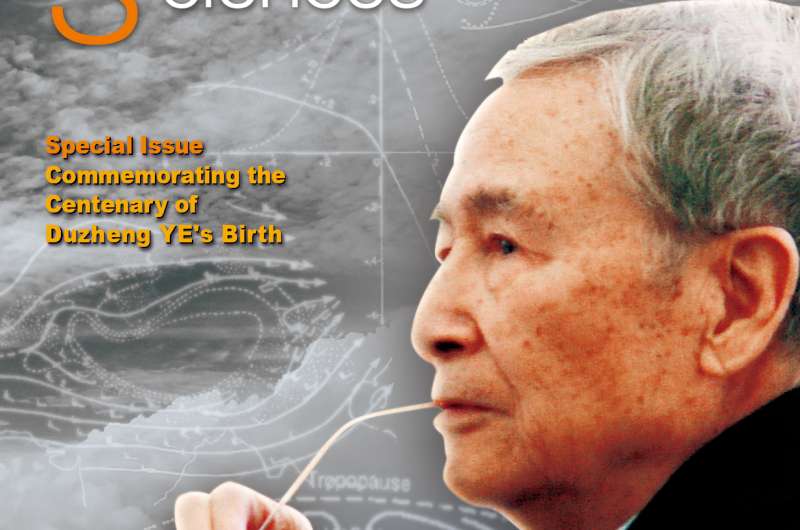Evolving perspectives on abrupt seasonal changes of the general circulation

It is not unusual that two similar scientific ideas on a particular phenomenon may echo each other across a long time span, unknown to the authors. Such an unintentional duet over history illustrates the amazing beauty of science by clearly showing that progress is not necessarily a linear process, but it is often accumulative.
A recent paper, "Evolving perspectives on the abrupt seasonal changes of the general circulation," which has just appeared in issue No. 10 of Advances in Atmospheric Sciences, tells such a story in the field of atmospheric science. The authors are Professor Jianhua Lu from the Sun Yat-sen University, and Professor Tapio Schneider from the California Institute of Technology.
Carl-Gustaf Rossby, the founder of modern dynamical meteorology, wrote in a short note published in 1951 that "there is [...] every reason to expect, during the next few years, an extremely vigorous development of Chinese meteorology, and as a result, many significant realistic contributions from that part of world." Exemplifying Rossby's expectation, Tu-cheng Yeh (Duzheng Ye)—one of Rossby's protégés—together with his colleagues Shih-yen Dao and Mei-tsun Li from the Chinese Academy of Sciences published "The abrupt change of circulation over the Northern Hemisphere during June and October" in the Rossby Memorial Volume eight years later.
Yeh-Dao-Li (1959) viewed the abrupt seasonal change of the general circulation, of which monsoons are a part, as a broad phenomenon, and further conjectured that it was caused by a certain type of "instability" in the atmosphere. They went on to propose a model experiment to test whether such an instability can occur without the inhomogeneities of the underlying boundary conditions (e.g., land-sea contrasts), which have traditionally been considered essential for monsoons and abrupt seasonal changes.
The advent of numerical general circulation models (GCMs) put the experiments proposed by Yeh-Dao-Li (1959) within reach. Indeed, numerical simulations successfully reproduce abrupt seasonal transitions of the general circulation, including monsoon transitions. However, by including lower-boundary inhomogeneities, these modeling studies were still not the numerical version of the experiment proposed by Yeh-Dao-Li (1959). A half-century passed after the publication of Yeh-Dao-Li (1959) before GCM experiments corresponding to the laboratory experiment proposed by Yeh-Dao-Li (1959) were conducted (Schneider and Bordoni, 2008; Bordoni and Schneider, 2008), though the authors of these recent studies were unaware of Yeh-Dao-Li's proposal decades earlier. They did, indeed, find abrupt seasonal transitions of the circulation without inhomogeneities at the lower boundary.
The paper in Advances in Atmospheric Sciences summarizes the circulation feedbacks that lead to the abrupt seasonal transitions found in the model experiments without lower-boundary inhomogeneities. It also emphasizes the work that still remains to be done to establish a comprehensive theoretical framework of seasonal transitions and to answer open questions such as:
- How does the strength and structure of a Hadley cell depend on external factors such as the solar declination angle?
- What controls when and how rapidly the circulation undergoes seasonal transitions?
- How and to what extent do surface inhomogeneities such as land-sea contrasts modulate the internal rearrangement of the atmospheric circulation during the seasonal transitions?
- Can the seasonal transitions be understood as an instability of the circulation as forcing parameters move through a critical region, as originally conjectured by Yeh-Dao-Li (1959)?
The paper appears in a special issue arising from last year's symposium in Nanjing organized by the Institute of Atmospheric Phyics, Chinese Academy of Sciences, to commemorate Professor Duzheng Yeh's more than 60 years of achievements before he passed away in 2013. Prof. Duzheng Ye was well known for his contributions to the theory and observation of the general circulation of the atmosphere. He was awarded the 48th IMO (International Meteorological Organization) Prize in 2003.
More information: Jianhua Lu et al, Evolving perspectives on abrupt seasonal changes of the general circulation, Advances in Atmospheric Sciences (2017). DOI: 10.1007/s00376-017-7068-4
Provided by Chinese Academy of Sciences

















